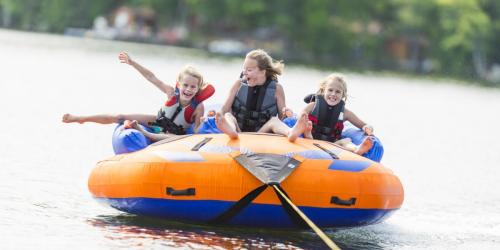Memories of a long hard winter fade into the past as Canadians begin to enjoy a favourite time of year – summer! Part of the fun includes water sports – sailing, power boating, water skiing, tubing, canoeing, kayaking, and swimming in our beautiful lakes. It’s never a bad idea to give some serious thought to water safety, and this is especially true when you are likely to be enjoying group activities that include young children.
Proactive Water Safety
Taking care to enjoy water sports safely means following basic safety protocols including the following:
- Assess your swimming skills and the differing abilities of those in your group. It’s never too late to learn how to swim or to improve. If you plan to venture out on the water, the ability to swim is imperative. A kayak or canoe can flip over easily, and a sailboat can overturn. Knowing how to swim is the first step toward preventing drowning which, unfortunately, is a frequent cause of premature death, especially for children aged 1 to 4 and males aged 15 to 44. If you are a parent, make sure that your children learn to swim – it’s a life skill! If you’re looking for swimming lessons in Alberta, Canadian Red Cross offers swimming instructions across the province.
- For swimmers, don’t swim alone, don’t jump or dive into shallow or unknown waters, don’t swim during a thunderstorm or poor weather conditions.
- Even for good swimmers, it is common sense to make sure that you are wearing a life jacket when you’re boating. There may be circumstances when you are not able to swim back to the boat, or to the shore, and a life jacket will help you float on the surface of the water and be clearly seen by rescuers. Make sure that your life jacket fits you well and is properly fastened and secured. Transport Canada has information on how to best choose a Personal Flotation Device (PFD).
- Make sure your equipment is in working order and that you know how to operate the vessel, particularly if it’s a rental. In Canada, you need “proof of competency” – that you have a basic understanding of how to operate your boat safely and know what to do in an emergency. Transport Canada has listed what counts as adequate proof HERE.
- Confirm there are enough life jackets or personal flotation devices on board for all your passengers. This is not optional, Transport Canada regulations mandate that there be “one Canadian approved personal flotation device or life jacket of appropriate size for each person on board.” Note: the regulation applies to motorized AND human-powered watercraft like paddle boards.
- Check the weather and boating conditions before you head out on the water. Keep in mind that the weather can change very quickly, so have a plan to get to safety quickly, if necessary.
- Never head out onto the water alone, no matter how tempting a meditative solo journey might be.
- Always let someone know where you are going, your route, and for how long you’re planning to be gone. Provide them with an emergency cell phone number.
- Have a way to call for help – take your cell phone, fully charged, in a waterproof case and, for significant adventures, consider a personal location beacon outfitted with a flotation sleeve.
- Always keep a close eye on young children with you, and make sure they are wearing properly fitted lifejackets and be prepared to perform first-aid procedures in case of emergencies.
- Protect your skin by wearing plenty of sunscreen and protective clothing, and be sure to remain fully hydrated. Wear sunglasses when on the water and a hat when outside in the sun.
If you or a loved one has been involved in a boating accident, contact CAM LLP for a free consultation.
Note: This blog post was originally published in July 2017 and has since been updated with relevant content

